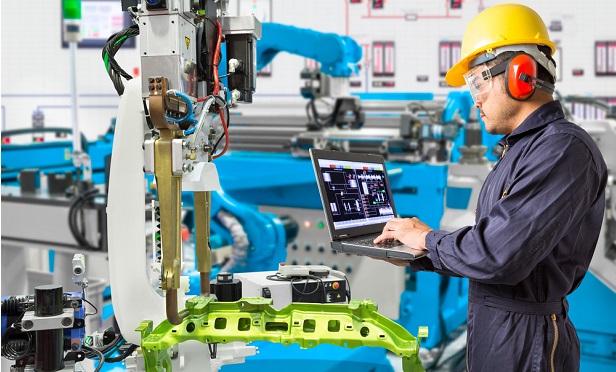 Thanks to the skills gap, five out of 10 skilled worker positions in U.S. manufacturing are vacant; skills are specific, require training and unique skill sets and can take months to fill. (Photo: Shutterstock)
Thanks to the skills gap, five out of 10 skilled worker positions in U.S. manufacturing are vacant; skills are specific, require training and unique skill sets and can take months to fill. (Photo: Shutterstock)In a tight labor market, it could be music to workers' ears to hear that there are so many skilled jobs available in the manufacturing industry—but not to employers' ears.
Yet, according to a new 2018 skills gap study by Deloitte and The Manufacturing Institute (the social impact arm of the National Association of Manufacturers), 2.4 million skilled jobs are projected to go unfilled by 2028. Currently the number of open slots is about 488,000. This gap, the projection adds, could mean that $454 billion in manufacturing GDP could be at risk in 2028, or more than $2.5 trillion over the next decade.
Related: Who's responsible for the employee skills gap?
In its earlier study, Deloitte and the Institute projected 2 million jobs going vacant between 2015 and 2025.
“Manufacturers in the United States are experiencing some of the highest levels of growth we've seen in decades, yet the industry seems unable to keep up with the resulting rebound in job growth,” Paul Wellener, vice chairman, Deloitte LLP, and U.S. industrial products and construction leader, said in a statement.
Wellener added, “With nearly 2 million vacant new jobs expected by 2028, compounded by 2.69 million vacancies from retiring workers, the number of open positions could be greater than ever and might pose not only a major challenge for manufacturers but may threaten the vitality of the industry and our economy.”
It's not as if industry is unaware, or not worried, with 73 percent of manufacturers citing this massive worker shortfall as their top concern, according to the NAM's latest “Manufacturers' Outlook Survey.” But thanks to the skills gap, five out of 10 skilled worker positions in U.S. manufacturing are vacant; skills are specific, require training and unique skill sets and can take months to fill.
The report highlights such jobs as skilled production workers, supply chain talent, digital talent, engineers, researchers, scientists, software engineers and operational managers.
The study identifies the top reasons there are so many vacancies: they include negative perceptions of the manufacturing industry (45 percent), followed by shifts in skill sets thanks to advanced technologies (36 percent) and retirement of baby boomers (36 percent).
Companies that will be hardest hit by this over the next three years will be those that are maintaining or increasing production levels to satisfy growing customer demand (51 percent). This will likely also pose a challenge for nearly half of manufacturers responding to new market opportunities and those increasing growth as measured by revenue (47 percent each), the report says.
Some of the ways companies are trying to cope include adding learning and development programs (39 percent); being more flexible in hiring (77 percent); training candidates on the job (65 percent); and even turning to retirees—with a pool of 2.69 million workers retiring from manufacturing jobs in the next 10 years, this last is a way for employers to hang on to the collective wisdom of older employees.
Last but not least are the addition of automated technologies (26 percent), relying more on technology (60 percent), raising wages (83 percent) and offering hiring bonuses (8 percent).
Read more:
- Prepare for a skills shift: what employers need to do to adapt their workforce
- Poor communication skills hinder millennials in workplace
- Expanding the talent pool: 10 groups employers are using to fill vacancies
© 2025 ALM Global, LLC, All Rights Reserved. Request academic re-use from www.copyright.com. All other uses, submit a request to asset-and-logo-licensing@alm.com. For more information visit Asset & Logo Licensing.







